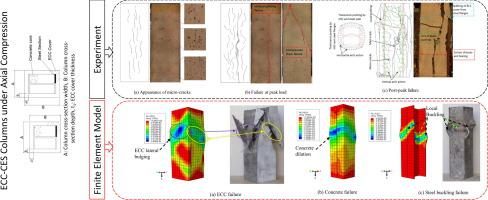Construction and Building Materials ( IF 7.4 ) Pub Date : 2020-09-14 , DOI: 10.1016/j.conbuildmat.2020.120783 M.K.I. Khan , C.K. Lee , Y.X. Zhang , Mohammad M. Rana

|
When using high strength materials in concrete partially encased steel (CES) composite columns, the major issues encountered are strain incompatibility of high strength steel and high strength concrete, premature concrete spalling and explosive brittle failure with poor ductility. In order to improve the compressive behaviour and ductility of CES columns, Engineered Cementitious Composites (ECC) encasement is proposed as a confinement and protection layer for concrete and steel, respectively. In order to evaluate the effectiveness of ECC cover on performance of CES columns, compressive behaviours of ECC-CES short columns were experimentally investigated to study the effects of material strengths, ECC encasement thickness, steel section shape and column’s aspect ratio. Findings were discussed and reported in terms of failure behaviours, load-deformation responses, post-peak ductility and toughness. Test results suggested that while only an insignificant increase of axial compressive resistance was observed, ECC encasement improved failure behaviour of ECC-CES columns by effectively controlling brittleness and explosive spalling of high strength concrete. ECC-CES generally showed improved ductility and energy absorption capacity but the strength enhancements were minimal. Reliability of current design codes in predicting the column ultimate strength was investigated and a new approach based on effective stress method was proposed. Finally, a 3D non-linear numerical model was also developed to predict the compressive behaviours of the proposed form of columns and a small scale parametric study was conducted.
中文翻译:

高强度钢ECC约束混凝土部分包裹钢组合柱的抗压性能
在部分包钢混凝土复合柱中使用高强度材料时,遇到的主要问题是高强度钢与高强度混凝土的应变不相容,混凝土过早剥落以及延展性差的爆炸性脆性破坏。为了改善CES柱的抗压性能和延展性,提出了工程水泥复合材料(ECC)护层分别作为混凝土和钢的约束层和保护层。为了评估ECC覆盖层对CES柱性能的有效性,通过实验研究ECC-CES短柱的压缩行为,以研究材料强度,ECC包裹厚度,钢截面形状和柱长宽比的影响。根据故障行为讨论和报告了发现,载荷-变形响应,峰后延性和韧性。测试结果表明,虽然仅观察到了很小的轴向抗压强度增加,但ECC套管通过有效控制高强度混凝土的脆性和爆炸剥落改善了ECC-CES柱的破坏性能。ECC-CES通常显示出改善的延展性和能量吸收能力,但强度增强却很小。研究了当前设计规范在预测柱极限强度方面的可靠性,并提出了一种基于有效应力法的新方法。最后,还建立了3D非线性数值模型来预测拟议形式的圆柱的压缩行为,并进行了小规模的参数研究。测试结果表明,虽然仅观察到了很小的轴向抗压强度增加,但ECC套管通过有效控制高强度混凝土的脆性和爆炸剥落改善了ECC-CES柱的破坏性能。ECC-CES通常显示出改善的延展性和能量吸收能力,但强度增强却很小。研究了当前设计规范在预测柱极限强度方面的可靠性,并提出了一种基于有效应力法的新方法。最后,还建立了一个3D非线性数值模型来预测拟议形式的柱的压缩行为,并进行了小规模的参数研究。测试结果表明,虽然仅观察到了很小的轴向抗压强度增加,但ECC套管通过有效控制高强度混凝土的脆性和爆炸剥落改善了ECC-CES柱的破坏性能。ECC-CES通常显示出改善的延展性和能量吸收能力,但强度增强却很小。研究了当前设计规范在预测柱极限强度方面的可靠性,并提出了一种基于有效应力法的新方法。最后,还建立了3D非线性数值模型来预测拟议形式的圆柱的压缩行为,并进行了小规模的参数研究。ECC包裹通过有效控制高强度混凝土的脆性和爆炸剥落,改善了ECC-CES柱的破坏性能。ECC-CES通常显示出改善的延展性和能量吸收能力,但强度增强却很小。研究了当前设计规范在预测柱极限强度方面的可靠性,并提出了一种基于有效应力法的新方法。最后,还建立了3D非线性数值模型来预测拟议形式的圆柱的压缩行为,并进行了小规模的参数研究。ECC包裹通过有效控制高强度混凝土的脆性和爆炸剥落,改善了ECC-CES柱的破坏性能。ECC-CES通常显示出改善的延展性和能量吸收能力,但强度增强却很小。研究了当前设计规范在预测柱极限强度方面的可靠性,并提出了一种基于有效应力法的新方法。最后,还建立了3D非线性数值模型来预测拟议形式的圆柱的压缩行为,并进行了小规模的参数研究。研究了当前设计规范在预测柱极限强度方面的可靠性,并提出了一种基于有效应力法的新方法。最后,还建立了3D非线性数值模型来预测拟议形式的圆柱的压缩行为,并进行了小规模的参数研究。研究了当前设计规范在预测柱极限强度方面的可靠性,并提出了一种基于有效应力法的新方法。最后,还建立了3D非线性数值模型来预测拟议形式的圆柱的压缩行为,并进行了小规模的参数研究。









































 京公网安备 11010802027423号
京公网安备 11010802027423号